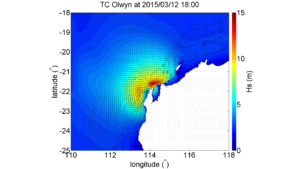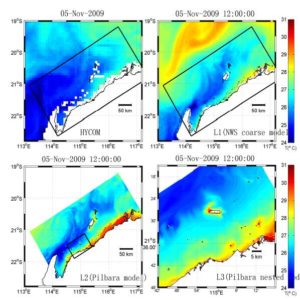Environmental drivers
Understanding the oceanic drivers shaping the Pilbara’s shelf and coastal marine ecosystems
Project lead: Ryan Lowe (UWA)
The PMCP environmental drivers project aimed to provide context to marine conservation efforts in the Pilbara-Ningaloo area by undertaking a regional assessment of the dominant environmental drivers that shape the current and future status of marine biodiversity assets in the region. The research team focussed on identifying the oceanic drivers that shape both shelf and coastal ecosystems, ranging from regional-scale ocean processes on the North West Shelf, down to the smaller-scale coastal processes that influence individual reefs.

Wave model predictions of the impact of Tropical Cyclone Olwyn during 2015.

Downscaled ocean model predictions of Pilbara coastal temperature variability.
The dominant oceanographic processes along the ~400 km Pilbara-Ningaloo coastline are both highly spatially- and temporally-variable. This area is also subject to episodic extreme events such as cyclones and marine heat waves.
Ocean currents on the North West Shelf tend to be highly-transient, driven by unsteady wind-driven shelf flows and the presence of large amplitude surface and internal tides. Collectively, these physical ocean processes control nutrient fluxes and in turn primary productivity of shelf ecosystems.
Inshore reef systems along the Ningaloo-Pilbara coast experience large gradients in wave and tidal exposure: from wave-dominated reefs in the south (i.e. at Ningaloo) to strongly tidally-forced reefs in the north. Reefs depend on the resulting fine-scale circulation patterns to exchange nutrients, heat and larval material between the region’s shallow reefs and the surrounding ocean. These reef systems are also episodically impacted by large tropical cyclones generating extreme waves, storm surges, etc. that can also be a dominant driver of the ecology of these systems.
The PMCP environmental drivers project used a combination of remote sensing, in-situ field observations and numerical modelling to assess the drivers of environmental variability across the region. Remotely sensed satellite images and ocean circulation models were used to assess the ocean circulation of biological productivity of shelf waves. Field instruments and the collection of water samples were also used to help assess circulation patterns, temperature variability and water quality both within and surrounding reef systems. High-resolution (reef scale) circulation and wave models were used to assess historical reef warming patterns in the Pilbara as well as impacts of tropical cyclones.
